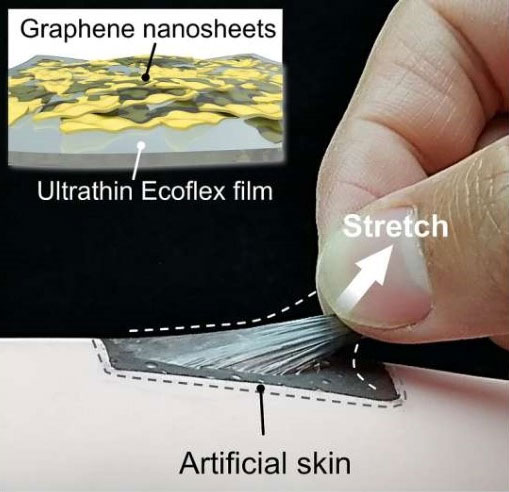Professor Chen Tao’s team at the Ningbo Institute of Materials Technology and Engineering (NIMTE), part of the Chinese Academy of Sciences (CAS), has invented a soft, biologically mimetic skin.
This tool functions to enhance stretch perception (SPS), thereby helping to recognize the transition from touch to pain sensation. The research has been published in the journal Advanced Function Materials.

The biological skin consists of elastic membranes and graphene nanoplates.
Organisms with soft biological tissues (e.g., skin) can achieve self-protection through passive mechanical stiffening and active awareness of external stimuli.
Before mechanical stiffening, the active protective layer can sense impending danger, significantly reducing the risk of injury. However, there are still many challenges to achieving effective active protection.
To address this issue, researchers at NIMTE have developed a new type of biologically mimetic skin. This is an elastic and conductive film (ECF). This skin comprises thin elastic membranes and graphene nanoplates.
These components are assembled with an interlocking structural interface. The SPS effect provides a soft skin with dynamic conversion functionality, transitioning from touch to pain perception.
The graphene-based two-dimensional (2D) ECF shows a positive correlation between the measurement coefficient and tension, similar to the sensory systems of organisms. Additionally, the synthetic biologically mimetic skin can achieve normal tactile perception under low tension conditions and pain perception above the stress threshold.
Moreover, the threshold value for deformation perception can be adjusted from approximately 7.2% to 95.3%. This indicates significant potential for developing diverse applications related to SPS.
The SPS-supported sensory system can effectively simulate the pain sensation of human tissues in cases such as excessive one-way stretching of muscle tendons and uneven stretching deformation of hand skin.
Inspired by the pufferfish, scientists at NIMTE have designed a biological model based on ECF to create self-supporting artificial skin. This allows for the detection of both non-contact and contact mechanical stimuli, while also actively inflating into a 3D shape.
Excessive 3D deformation can be effectively recorded thanks to the typical SPS effect. Scientists believe that this new technology shows promise in fields such as human-machine interaction, smart prosthetics, and robotics.


















































